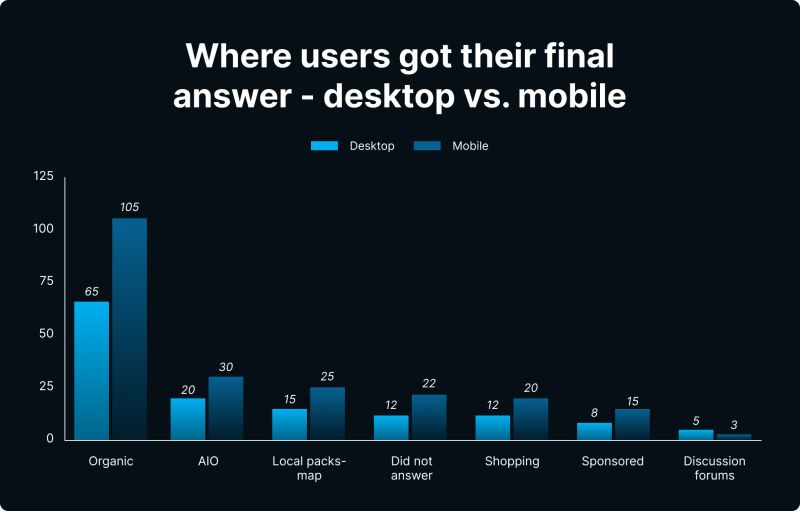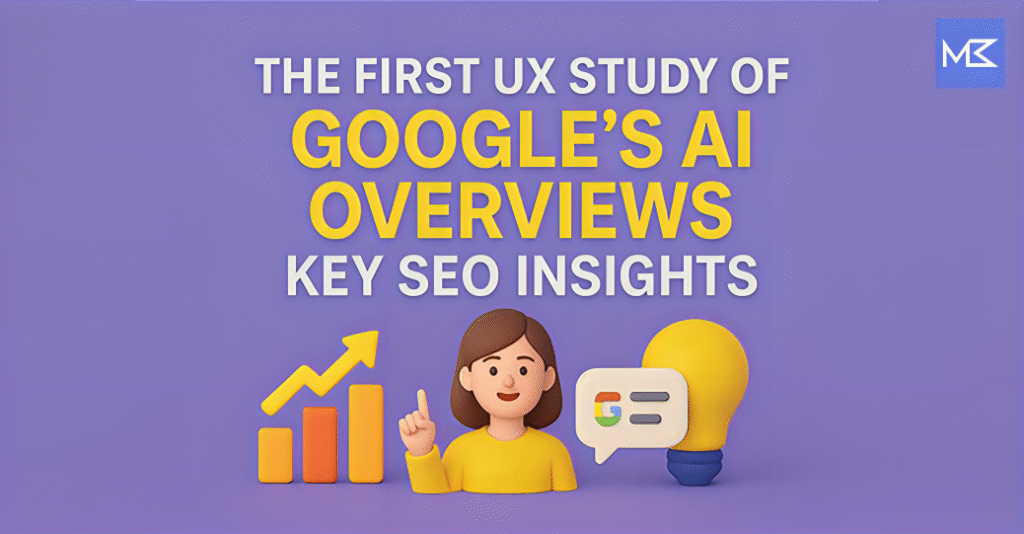Google’s AI Overviews (AIOs) are flipping the search game upside down, and Growth Memo’s groundbreaking UX study of 70 users gives us the first real look at how people interact with these AI-generated summaries. The findings are wild: clicks to websites are crashing, most users only skim the top of AI answers, younger searchers vibe with AIOs while older ones cling to traditional links, and trust in sources is now everything. This post dives into the study’s major insights and serves up practical SEO strategies to navigate this new search reality.
AI Overviews Are Killing Clicks (Especially on Desktop)
AIOs are gobbling up clicks that used to go to websites. The study shows that when an AIO pops up, click-through rates (CTR) to external sites take a brutal hit:
●Desktop: CTR plummets from ~28% to 11% – fewer than 1 in 8 users click a traditional result.●Mobile: CTR drops from 38% to 21%.
Why? AIOs often deliver enough info to satisfy users without needing to click further. While 4 out of 5 users eventually click something, those clicks often hit other Google SERP features – think maps, YouTube videos, Reddit threads, or “People Also Ask” boxes – rather than classic blue links. For transactional or commercial queries, users still turn to organic links, forums, videos, or local listings, but AIOs are siphoning off a huge chunk of clicks that websites used to bank on. To dive deeper into how AI Overviews are reshaping search trends in 2025, check out our detailed analysis here.
What this means for SEO:
●Expect less traffic: Organic clicks, especially on desktop, could get sliced in half (or worse) when AIOs appear.●It’s about visibility now: Growth Memo calls this a shift from a “click economy” to a “visibility economy.” Even a #1 ranking might not drive traffic if an AIO steals the spotlight.●Actionable tip: Optimize to get your content or brand cited inside the AIO to stay in users’ line of sight.
Most Users Only Read the Top of the AI Answer
Users treat AIOs like a quick cheat sheet. The study found that 70% of people never read past the top third of the AIO content, with a median scroll depth of just 30%. Anything buried lower might as well be invisible. The initial lines and sources cited at the top get nearly all the attention.
How users engage:
●88% click “Show More” when the AIO is truncated, showing they want the full answer.●Yet, 86% just skim the content, spending only 30–45 seconds on average before bouncing to something else.●One user summed it up: “I like AIO, but I still prefer Reddit,” signaling that after skimming, many seek community answers for depth.
What this means for SEO:
●Top placement is everything: If your brand or content isn’t cited early in the AIO, most users won’t see it.●Craft AI-friendly content: Use concise, scannable formats (think bullet points, tight paragraphs, or FAQs) to boost your chances of being featured high up.●Actionable tip: Add “Key Takeaways” or structured data to make your content easy for both AI and skimming users to digest.
Trust Is the New Filter: Authority Outranks Relevance
Relevance used to rule, but now trust is the first gatekeeper. Users apply a two-step filter: 1) “Do I trust this source?” then 2) “Does it answer my question?” Brand authority and trustworthiness are now the top priority.
Key findings:
●58% of the time, users picked a known brand, authority site, or trusted domain (.gov, .edu) first, saying things like “I trust Yelp” or “US News is trustworthy.”●39% of results were skipped if the snippet seemed off-topic, even from a trusted site.●Trust in AIOs themselves is solid – users rated it ~3.4 on a 1 (low) to 4 (high) trust scale. Trust grows when users see credible sources cited or dig into citations.

This flips SEO strategy on its head. It’s not enough to match search intent; you need to scream authority so users feel confident clicking you. As Growth Memo notes, “the new currency is authority, which now outranks search intent relevance.”
What this means for SEO:
●Build E-E-A-T signals: Get expert endorsements, earn links from .edu/.gov sites, and flaunt credentials (e.g., “Trusted by [Industry Leader]”).●Get cited in AIOs: Being a cited source boosts visibility and lends the AIO credibility, reducing the chance users look elsewhere.●Actionable tip: Highlight trust signals upfront in content (author bios, certifications) to pass the “trust check” reflex.
Younger Users Embrace AIO, Older Users Stick to “Blue Links”
The study revealed stark generational and device differences in AIO adoption:
●Younger users (25–34, mobile) are AIO super-fans, choosing the AI answer as their final answer 50% of the time. They scroll more too – 54% of the AIO panel vs. 29% on desktop.●Older users (55+) are skeptical, preferring traditional blue links. They voiced doubts about AIOs for high-stakes queries (e.g., “I’d go straight to PayPal for accuracy” for a bank transfer question).●Mobile vs. desktop: Mobile users pick the first screen of results (AIO or top organic link) 71% of the time, while desktop users click AIO citation links less often (7.4% vs. 19% on mobile).
What this means for SEO:
●Know your audience: If targeting younger, mobile users, expect many to stop at the AIO. For older or YMYL (Your Money, Your Life) audiences, traditional rankings still matter.●Prioritize mobile: Top spots (AIO or organic) are critical on small screens where users rarely scroll.
● Actionable tip: Tailor strategies by device – use desktop for brand exposure in AIOs, mobile for driving actual clicks.
Users Still Double-Check via Reddit, YouTube & Forums
Even with AIOs, users crave validation. The study found 18% of users opened Reddit threads, YouTube videos, or forums to double-check info after seeing an AIO or top result. Social proof and community content are huge for building confidence, especially for decisions needing extra assurance (e.g., “best months to buy a car”).
●Users often seek Reddit for personal experiences, YouTube for visual demos, or forums for niche discussions.●One user said, “I still prefer Reddit,” showing a preference for human perspectives over AI summaries.●Growth Memo notes: “Many outbound clicks go to Reddit, YouTube, or forum posts – social proof seals decisions.”
What this means for SEO:
●Own the validation step: Be present where users double-check – create YouTube content, engage on Reddit, or contribute to forums.●Don’t spam: Provide genuine value (e.g., helpful answers, quality videos) to build trust in these spaces.
● Actionable tip: For key topics, produce complementary content (e.g., a YouTube video for a blog post) to capture users seeking social proof.
Adapting Your SEO Strategy for the AIO Era
AIOs aren’t the death of SEO, but they demand a pivot. Here are data-driven strategies to stay ahead:
●Shift Your KPIs from Rank to Visibility: Rankings are losing their edge. Track AIO visibility – are you cited in the AI summary? Are you a top source? Tools to monitor AIO presence are emerging, so stay tuned.●Invest in Instant Trust Signals (Authority): Bolster E-E-A-T with expert quotes, high-quality backlinks, and clear credentials. If users see you as trustworthy, they’re more likely to click.●Optimize Content for Skimmers and AI Extraction: Use headings, bullets, and concise summaries to make content AI- and user-friendly. FAQs or “Key Takeaways” boxes are gold for AIO inclusion.●“Own” the Validation Click (Reddit, YouTube, etc.): Seed helpful content on platforms users turn to for confirmation. A YouTube channel or active Reddit presence can keep your brand in the loop.●Adjust Strategies for Desktop vs. Mobile: Treat desktop as a branding play (AIO exposure) and mobile as a traffic driver (fight for top spots). Forecast lower desktop CTRs in your plans.
Conclusion: From Rank to Visibility – The New World of Search
Growth Memo’s UX study confirms it: search is now a visibility-driven trust economy. If you’re not in the AIO (ideally near the top), you’re invisible to many users. SEO isn’t just about ranking #1 anymore – it’s about being seen and trusted when Google’s AI answers the query. Authority is the new king, so invest in E-E-A-T, optimize for AI inclusion, and meet users where they validate info. Need help adapting your SEO strategy for this AI-driven landscape? Reach out to our team today for expert guidance.

